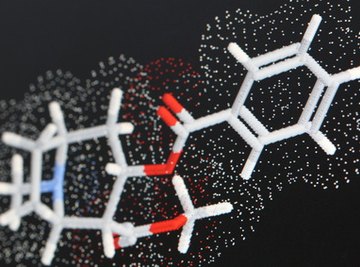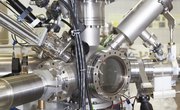
Infrared spectroscopy, also known as IR spectroscopy, can reveal the structures of covalently bonded chemical compounds such as organic compounds. As such, for students and researchers who synthesize these compounds in the laboratory, it becomes a useful tool for verifying the results of an experiment. Different chemical bonds absorb different frequencies of infrared, and infrared spectroscopy shows vibrations at those frequencies (displayed as 'wavenumbers') depending on the type of bond.
Function
Infrared spectroscopy serves as one useful tool in the chemist's toolbox for identifying compounds. It does not give the exact structure of a compound, but rather shows the identity of the functional groups, or moieties, in a molecule - the different segments of the molecule's composition. As such an inexact tool, IR spectroscopy works best when used in conjunction with other forms of analysis such as melting point determination.
In professional chemistry, IR has largely gone out of fashion, replaced by more informative methods like NMR (nuclear magnetic resonance) spectroscopy. It still enjoys frequent use in student laboratories, as IR spectroscopy remains useful in identifying important characteristics of molecules synthesized in student lab experiments, according to Colorado University Boulder.
Method
Generally, the chemist grinds a solid sample with a substance like potassium bromide (which, as an ionic compound, does not show up in IR spectroscopy) and places it in a special device to allow the sensor to shine through it. Sometimes she or he mixes solid samples with solvents like mineral oil (which gives a limited, known reading in the IR printout) to use the liquid method, which involves placing a sample between two plates of pressed salt (NaCl, sodium chloride) to allow the infrared light to shine through, according to Michigan State University.
Significance
When infrared 'light' or radiation hits a molecule, the bonds in the molecule absorb the energy of the infrared and respond by vibrating. Commonly, scientists call the different types of vibrations bending, stretching, rocking or scissoring.
According to Michele Sherban-Kline at Yale University, an IR spectrometer has a source, an optical system, a detector and an amplifier. The source gives off infrared rays; the optical system moves these rays in the correct direction; the detector observes changes in the infrared radiation, and the amplifier improves the detector signal.
Types
Sometimes spectrometers use single beams of infrared and then split them into component wavelengths; other designs use two separate beams and use the difference between those beams after one has passed through the sample to give information about the sample. Old-fashioned spectrometers amplified the signal optically, and modern spectrometers use electronic amplification for the same purpose, according to Michele Sherban-Kline at Yale University.
Identification
IR spectroscopy identifies molecules based on their functional groups. The chemist using IR spectroscopy can use a table or chart to identify these groups. Each functional group has a different 'wavenumber', listed in inverse centimeters, and a typical appearance—for example, the stretch of an O-H group, such as that of water or alcohol, occupies a very wide peak with a wavenumber near 3500, according to Michigan State University. If the compound synthesized does not contain any alcohol groups (also known as hydroxyl groups) this peak can indicate the inadvertent presence of water in the sample, a common student error in the laboratory.
References
About the Author
Eri Luxton holds a B.A. in liberal arts, an M.F.A. in creative writing, a first aid certification and a biomedical ethics certificate. She has worked as an English teacher overseas and as a local volunteer in first aid and in technology troubleshooting. Luxton mentors students in chemistry and physics while studying toward a pre-health sciences degree.
Photo Credits
cocaine molecule 1 image by Yurok Aleksandrovich from Fotolia.com
